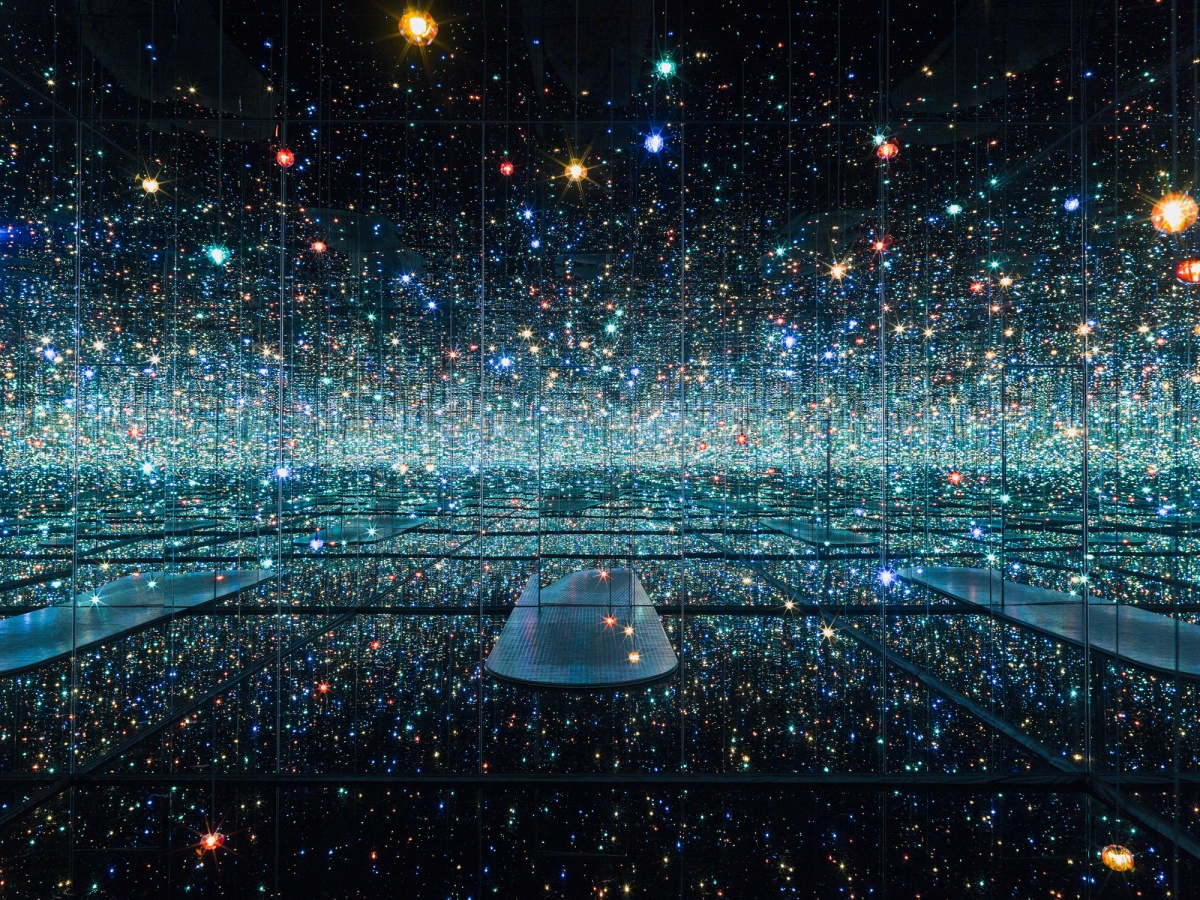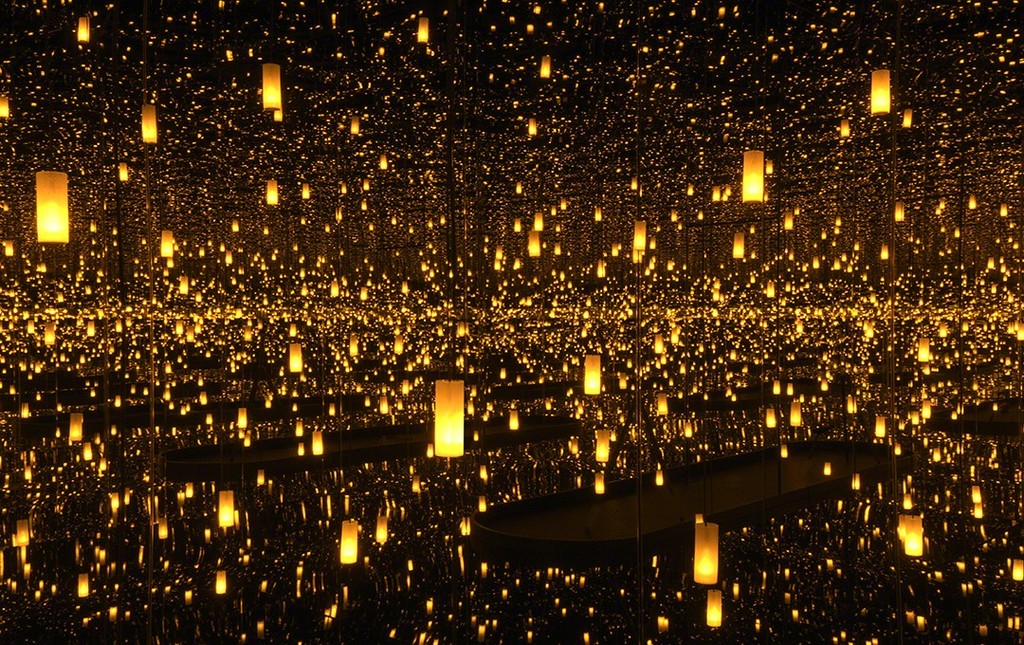Polka Dots and Infinity Mirrors
You've seen it all over Instagram, blogs, the news, social media... you name it! Japanese artist Yayoi Kusama's Infinity Mirrors exhibition has been blowing up the Internet with its very aesthetic and eye-pleasing mirror installations. When I heard that the exhibit was coming to Toronto, I really wanted to experience the art for myself... but alas, the tickets were sold out almost immediately. (And quite frankly, I wasn't sure I wanted to wait 2 hours in total to see each installation for 20 seconds.) Although I didn't get to see it in person, her art still intrigued me - what inspires her creativity? What does each installation mean? What messages do she want to share with the world?
Background
Yayoi Kusama (b. 1929) is a Japanese contemporary, avant-garde artist whose works consist primarily of sculptures and installations; she also does paintings, performances (called Happenings), poetry, film, fiction, and fashion, among others. At 10 years old, Kusama started using polka dots, loops, and nets (repetitive patterns of polka dots and tiny points of light) as motifs in her artwork - her representations of the idea of infinity - which remained prominent in all her latter works. Kusama started doing art as a creative, therapeutic outlet and coping mechanism for her mental illness, and as a way to process her hallucinations. For Kusama, art was essential to her survival. Since at a young age, Kusama developed a fear of and aversion to sex, due to witnessing her father's sexual life outside of the family as sent by her mother, and because of her father's infidelity, Kusama was also abused by her mother, used as an outlet. This traumatic childhood experience translated into her art, in phallic forms.
“My artwork is an expression of my life, particularly of my mental disease.”
Following the Second World War, Kusama, at 19 years of age, went to Kyoto to study the traditional Japanese style of painting known as Nihonga. It was there that she began experimenting with concepts of abstraction. As she felt the Japanese culture was too conservative for her art at the time, Kusama subsequently moved to New York. "For art like mine, [Japan] was too small, too servile, too feudalistic, and too scornful of women. My art needed a more unlimited freedom, and a wider world," Kusama once said. While in America, Kusama was influenced by the anti-war movements, the presidential election, and other social elements and subcultural movements. From then on, she became a huge success, influencing the likes of Andy Warhol and Yoko Ono. In 1977, she checked herself in to the Seiwa Mental Hospital and has been living and creating there (by choice) ever since.
The Art
"Immerse yourself in six of these kaleidoscopic environments where you will be endlessly reflected within fantastic landscapes." (Art Gallery of Ontario)
What do you see when you look into a mirror? Through Infinity Mirrors, Kusama creates an illusion of infinite space, celebrating human life and its aftermath.
As mentioned earlier, with the exhibit's aesthetically-appealing "vibes", visitors can expect to see many young people holding up their phones, capturing and recording their experience for social media. Some say that social media and millennial narcissism is spoiling the gallery experience of just being in the presence of the art: the immersive experience that Kusama intended. Adelina Vlas, the AGO's associate curator of contemporary art, says that "the hype can't replace the experience. Sure, take a selfie, but if you aren't present in the moment you are missing an opportunity to really experience the work." But perhaps this was something Kusama had intended. This article from NOW Toronto and this from Macleans addresses just this "issue", in a very articulate manner - I definitely recommend you reading these if you're curious about how the selfie plays a role in Infinity Mirrors.
Love Forever is a representation of civil rights, sexual liberation, and the anti-war movement that occurred in the 1960s. The installation itself is hexagonal, mirrored on all sides. There are 2 square "peepholes" that invite viewers to look in, seeing both their own reflection and another viewer, repeated into infinity. At the time of this piece of art, Kusama was experimenting with new technology - "machine for animation", as she called it.
With this repetitive illusion, Kusama wanted her viewers to have an out-of-body experience. Like stars in the galaxy, LED lights hang from the mirrored ceilings and flicker in a rhythmic pattern, seemingly suspending both space and time. The viewer's body activates the environment and, simultaneously, vanishes into infinite space.
Kusam indeed has a seemingly eternal love for pumpkins. The pumpkin motif appeared in some of her earlier drawings in the late 1940s, and has repeatedly shown up since. This particular installation is a space for viewers to recall fairytales and fantasy (like Cinderella, perhaps?).
A representation of her aversion to sex, Phalli's Field creates a hallucinatory scene of phallic surfaces. The mirrors allowed Kusama's vision to transcend physically and mentally taxing limitations during the creative process, and allows for a participatory experience by including and making visitors a part of the work. Her use of mirrors in this piece of art subsequently paved the way for the future infinity mirror installations that viewers have grown to adore.
Viewers are greeted with flickering golden lanterns, the shimmering pattern of light contrasting with the seemingly endless void of mirrored black space. This installation is a reflection of the experience of death, and the potential of the afterlife; the impermanence of life, and the certitude of death. The lanterns recall the Japanese tradition of toro nagashi - paper lanterns are released and float down the river to guide ancestral spirits back to their reseting places. This ceremony takes place on the final night of the Obon Festival, and often commemorates victims of atomic bombs.
Visitors are able to experience these large polka dot balloons in three different ways: a) inside a mirrored room (pictured above), b) through another "peephole", and c) as it is, filling up the gallery space. The balloons occupy the entire gallery space, engaging visitors with contrasting scales, through being enveloped by the massive balloons hanging from ceilings or sitting on the floors, versus squinting through a small hole to see mirrored infinity. Kusama herself provides the soundtrack for this experience, hauntingly singing one of her own poems on a nearby video screen
This installation is unique from the others of this exhibit, as it does not use mirrors. Instead, visitors are invited to partake in the journey to infinity one polka dot at a time, by placing polka dot stickers wherever they want on the once-pure white room of furniture and everyday objects. Kusama highlights the concept of obliteration as the pristine white space is gradually covered by brightly coloured dots.
Aside from the Infinity Mirrors, visitors can also see various paintings, works on paper, and sculptures of Kusama's. This supplementary installation - Narcissus Garden - is free with admission, and features 1,300 stainless-steel mirror balls, all spread throughout the Signy-Eaton gallery. As one of her first pieces of performance art, Kusama attempted to sell each mirror ball to visitors, for $2, with a sign reading "Your Narcissism for Sale". The balls provide an infinite reflective field, and when gazing into them, visitors are confronted by their own vanity, ego, and self-importance.
Onwards
After learning about her history and the meaning behind her art, I want to visit this exhibit - or any of hers, honestly - sometime and somewhere in the future. (And maybe I'll challenge myself to let go of my phone for the time being as well.) For those who didn't have a chance to visit Infinity Mirrors, or who want to learn more about Kusama and her life in art, the Toronto International Film Festival (TIFF) is showing a documentary film called Kusama - Infinity. It will speak of the various triumphs and trials in her life, her competition with Andy Warhol in the 60s, the battle against sexism and racism in America and how it influenced her artwork, her hallucination of polka dots, and her life story. Kusama - Infinity premieres at the TIFF on Friday May 11th and will play until May 17th. Click here to buy tickets.
Needless to say, I'm definitely going to try and make one of the shows.













